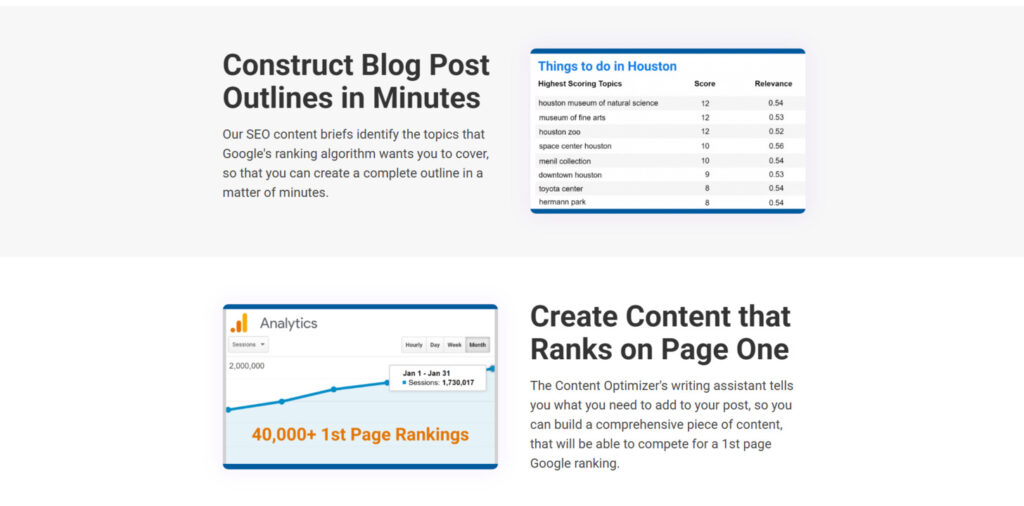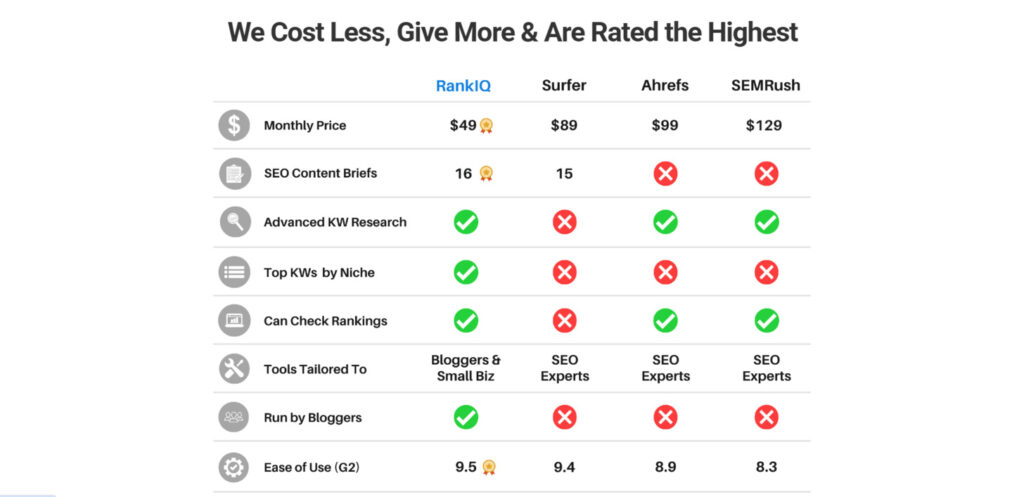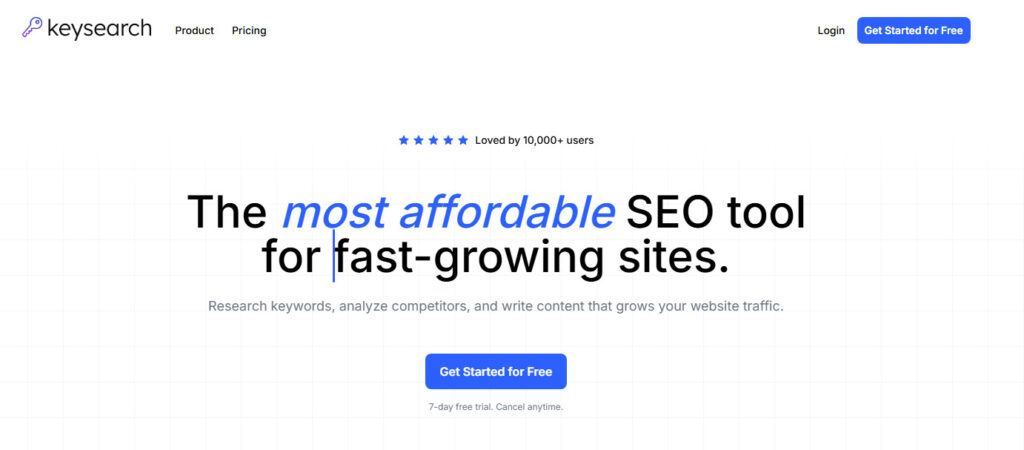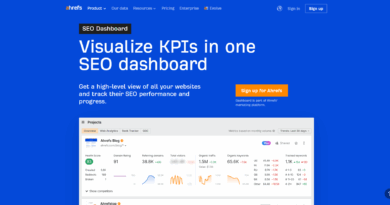RankIQ Review: The Ultimate SEO Tool for Bloggers
Short verdict: for bloggers focused on creating consistent, search-driven content, RankIQ is a practical, blogger-first SEO tool that streamlines keyword research and on-page optimization — many users report first-page placements within a few months when they follow the tool’s recommendations.
What to expect in this review: a clear breakdown of RankIQ’s keyword library and content optimizer, a walkthrough of the typical workflow for new and updated content, pricing and report limits, comparison with other SEO tools, tips to maximize results, and verifiable examples so you can test the tool on your own blog.
What is RankIQ and How Does It Work?

RankIQ is an AI-powered SEO tool designed primarily for bloggers and content creators. Launched and popularized by Brandon Gaille (host of The Blogging Millionaire podcast), it focuses on giving blog owners a streamlined way to perform keyword research and optimize posts so they can compete in Google search results without needing an SEO background.
Unlike broad SEO suites aimed at agencies and enterprise users, RankIQ zeroes in on the specific needs of bloggers: finding low-competition keywords, building content that targets search intent, and speeding up the time it takes for new posts to start attracting organic traffic. The result is a simpler workflow for creators who want more traffic to their blog without spending hours on manual analysis.
At a high level, RankIQ has two core components that work together:
- Curated Keyword Library — a niche-organized collection of hand-picked, low-competition keyword ideas that prioritize faster ranking potential. Example: instead of returning thousands of vague suggestions, the library might surface a long-tail keyword like “easy keto lunch ideas for beginners” with a low-competition score and a realistic visits-per-year estimate.
- Content Optimizer — after you pick a keyword, the optimizer analyzes the top-ranking pages on Google and produces an actionable SEO report: recommended word count, target content grade, related subtopics to include, and headline/title suggestions. It effectively translates the SERP landscape into concrete editing notes for your draft.
Quick workflow summary: pick a keyword from the library → run an AI SEO report → write or paste your content into the optimizer → follow the recommended topics and improve your content grade → publish and monitor results in Google Search Console.
What to expect next in this review: a deeper look at the keyword library and content optimizer features, how RankIQ’s AI reports interpret search engine results, and practical steps you can take to test the tool on your own blog.
Key Features of RankIQ
Keyword Library
The Keyword Library is the heartbeat of RankIQ — a curated collection of keyword ideas organized by niche so bloggers can skip noise and focus on opportunities they can realistically rank for. Instead of returning thousands of generic suggestions like many keyword research tools, RankIQ surfaces hand-picked, low-competition keywords with clear metrics to help you prioritize what to write next.
What you’ll see for each keyword:
- Competition score — a simple indicator of how difficult it is to rank for the keyword (lower = easier).
- Estimated visits per year — an approximation of search demand so you can weigh traffic potential.
- Time to rank — a practical estimate (e.g., ultra-fast, fast, average) that factors in current SERP strength and typical ranking timelines.
How to apply the library (quick steps):
- Filter by niche and time-to-rank to find keywords that match your goals (fast wins vs long-term).
- Review the visits-per-year and competition score to estimate ROI for each keyword.
- Add the chosen keywords to your content plan and run an AI SEO report for the highest-priority terms.
Mini example: the library might recommend a long-tail keyword like “best budget pet grooming kit 2024” that shows low competition, ~2,400 estimated visits/year, and a “fast” time-to-rank — a clear, actionable opportunity for a niche blog to target.
Limitations to note: the library is curated, so super-ultra-narrow micro-niches may be underrepresented. If your niche isn’t present, RankIQ offers a request option to have the team research and add keywords for you.
Content Optimizer

The Content Optimizer converts SERP analysis into an actionable content brief for each keyword. After you select a keyword, the optimizer inspects top-ranking pages on Google and recommends what to include in your post so it can compete for page one.
Main outputs from the optimizer:
- Recommended word count — based on the length of top-ranking pages so you can match or exceed topical breadth.
- Content grade — a measurable score (ranges commonly shown as F → A++) indicating how well your draft matches the optimizer’s recommendations.
- Related keywords & subtopics — semantically relevant terms and headings to include for topical completeness.
- Title analysis & headline suggestions — sample titles that better match search intent and CTR opportunities.
Practical tip: paste a draft into the optimizer, then systematically add the missing topics and related keywords it suggests. As you include these terms and expand sections to hit the recommended word count, your content grade climbs — the optimizer often indicates a target grade (A+ or A++) for the best chance at first-page placement.
Sample title suggestions you might receive: “Best Budget Pet Grooming Kit 2024 — Top Picks Under $50” or “How to Choose a Budget Pet Grooming Kit: 5 Must-Have Tools.” These are crafted to reflect intent and include the target keyword while improving click-through potential on the SERP.
When the optimizer might be less helpful: for highly technical articles that rely on deep expertise or primary research rather than topical breadth, the suggested subtopics may feel generic. Use the optimizer as a structural guide, not a replacement for domain expertise.
AI SEO Reports
RankIQ’s AI SEO reports are the analysis engine that powers the optimizer. When you run a report on a target keyword, the AI evaluates the current top search results and produces a concise roadmap: who your competitors are, what topics they cover, and where gaps exist you can exploit.
Report components typically include:
- Competition analysis — a snapshot of how strong the current top-ranking pages are.
- Estimated time to rank — a timeframe estimate that helps prioritize quick wins vs long-term plays.
- Topic and subtopic suggestions — a prioritized list of headings, FAQs, and secondary keywords to include.
- Title & meta recommendations — suggested headline formats and meta text ideas to improve CTR.
- Competitor analysis — short summaries of what top pages do well and what they miss.
How to use reports effectively: treat them as a content brief generator. Export or copy the suggested subtopics into your outline, aim for the recommended word count, and use the title recommendations to test higher CTR titles on social or in search snippets.
Note on limits: the Standard plan typically includes a fixed number of reports per month (historically 16). If you’re running a content-heavy operation, plan your reports—mix new content creation with audits to update underperforming pages.
Rankings Audit
The Rankings Audit plugs into Google Search Console to show how your site performs in real-world search results. It surfaces the keywords bringing the most traffic, pages gaining or losing visibility, and overall organic traffic trends — giving you a prioritized list of posts that need updates.
Audit outputs you can act on:
- Top-performing keywords and their pages — double down on high-traffic winners with internal links and fresh content.
- Pages with traffic contraction — identify content that’s lost rankings and run an AI SEO report to refresh it.
- Overall organic traffic summaries and growth charts — use these to measure the impact of RankIQ-driven updates over time.
Action checklist (try this feature): run the Rankings Audit monthly → identify 3 pages with declining traffic → run reports for their primary keywords → update articles using the Content Optimizer → republish and monitor GSC for recovery.
Bottom line: the Key Features work as a system — the keyword library feeds opportunities, AI SEO reports translate SERP gaps into briefs, the content optimizer helps you implement the brief, and the rankings audit closes the loop by showing what to improve next.
RankIQ Pricing Plans

RankIQ offers tiered plans that scale with how much keyword research and AI SEO reporting you need each month. The primary distinction between plans is the number of reports you can run per month — all plans provide access to the same core features: the keyword library, content optimizer, and rankings audit. Before purchasing, re-check live pricing at the RankIQ site because subscription amounts and promotions can change.
| Plan | Price | Reports/Month | Features |
| Standard | $49/month | 16 | Keyword Library, Content Optimizer, Rankings Audit, Facebook Group Access |
| Pro | $99/month | 36 | All Standard features |
| Agency | $199/month | 80 | All Standard features |
There’s also a Lite option historically available for about $29/month (8 reports) that is sometimes offered via support or promotional channels — if you need fewer reports, ask RankIQ about Lite access when you sign up. Remember: reported prices here reflect the typical public tiers, but RankIQ occasionally runs discounts or changes plan structures, so confirm current pricing and any annual payment discounts on the official site.
Who each plan is best for:
- Standard (16 reports/month) — best for most solo bloggers who want to create a mix of new posts and updates each month (a practical split is eight new posts + eight content updates).
- Pro (36 reports/month) — ideal for mid-size blogs or small teams producing more new posts and optimizing at scale.
- Agency (80 reports/month) — suited to agencies or publishers managing multiple sites and high-volume content calendars.
Short ROI example: if a targeted keyword from the keyword library brings an extra 500 organic visits per month and your blog monetizes those visits at $0.20 per visit, that’s $100/month — two well-ranked keywords can offset a Standard plan’s monthly cost. Your exact ROI will vary based on niche, ad RPM, and affiliate conversions.
Facebook group and access notes: all plans include access to the RankIQ Facebook community — a place many users reference for tips, creative title ideas, and occasional direct feedback from Brandon Gaille and the team. Use the group to speed up learning and discover how other bloggers are using the tool.
Ready to Improve Your Blog’s SEO?
If you want to try RankIQ, consider starting on the Standard plan to test the keyword library and content optimizer. If you need more reports per month after testing, upgrade to Pro or Agency to scale your keyword research and content optimization workflow.
How to Use RankIQ Effectively

Using RankIQ is designed to be straightforward for bloggers — the platform guides your keyword research and on-page optimization so you can focus on writing great content. Below is a practical, time-estimated workflow for both creating new posts and updating existing ones, plus quick troubleshooting tips and a starter test plan to help you get results faster.
Quick-start (3 steps)
- Pick a low-competition keyword from the Keyword Library (15–45 minutes).
- Run an AI SEO report and use the Content Optimizer to build your draft (1–3 hours depending on post length).
- Publish, then monitor with the Rankings Audit and Google Search Console (ongoing; check weekly for first 8–12 weeks).
For New Content (recommended process)
- Browse the Keyword Library and filter by niche and time-to-rank to find low-competition keywords that match your site — aim for keywords labeled “ultra-fast” or “fast” if you want quicker results (15–45 minutes).
- Select a primary keyword and run an AI SEO report to generate the content brief (5–10 minutes).
- Review the recommended word count and draft an outline using the suggested subtopics (20–60 minutes for outline).
- Write your blog post, incorporating the suggested keywords and subtopics. Target the recommended word count — for many RankIQ suggestions this might fall in the 1,200–2,000 word range depending on the topic.
- Paste your draft into the Content Optimizer to check your content grade and see which related keywords or headings are missing (5–10 minutes).
- Make targeted edits: add missing subtopics, expand sections to match the word count guidance, and refine headings/titles (30–90 minutes).
- When the optimizer shows the target grade (often A+ or A++), publish your optimized post and schedule GSC monitoring (publish + submit URL to Google).
Example (concrete)
If the library suggests the keyword “easy keto lunch ideas for beginners” with a recommended word count of 1,600 words and a “fast” time-to-rank, you would:
- Run the AI SEO report → get subtopics like “meal prep tips,” “keto-friendly swaps,” and “sample meal plan.”
- Write sections covering each subtopic and include the related keywords the optimizer recommends.
- Paste into the content optimizer, add the missing subtopic “simple snacks,” and raise the grade to A+ before publishing.
For Updating Existing Content
- Run the Rankings Audit to identify underperforming posts with declining traffic or impressions (10–20 minutes).
- Choose the primary keyword for the post and run an AI SEO report to see current SERP expectations (5–10 minutes).
- Copy your existing content into the Content Optimizer and note gaps (missing subtopics, related keywords, or insufficient word count).
- Update the article: add the missing subtopics, improve headings, expand thin sections to meet recommended word count, and refresh date/metadata (30–120 minutes depending on scope).
- Republish the updated post and resubmit to Google; monitor the Rankings Audit and GSC for recovery over the next 4–12 weeks.
Starter test plan (first 30 days)
- Run 3–5 reports in week 1. Use 1 report to create a new post and 2–4 reports to update existing posts.
- Publish the new post and republish the updated posts within weeks 2–3.
- Use the Rankings Audit weekly to watch impressions, clicks, and average position; expect to see movement in 4–12 weeks for fast keywords.
Troubleshooting & tips
- If your content grade doesn’t improve after adding recommendations, check that you actually included the suggested headings and phrases (not just synonyms). The optimizer looks for specific topical coverage and related keyword presence.
- If you hit the recommended word count but still don’t rank, examine on-page elements: title tag, meta description, H2/H3 structure, and internal linking to authority pages.
- For posts that still struggle after optimization, consider off-page factors like backlinks. RankIQ helps on-page relevance, but backlinks and domain authority influence first-page placement.
- Keep readability high — don’t force keywords. Balance optimization with natural, valuable content for readers.
Using RankIQ regularly — both for new posts and for updating older ones — helps you maintain a content pipeline that targets low-competition keywords and improves the chances of reaching the first page on Google. If you’re new to the tool, follow the starter test plan and scale up report usage as you see results.
RankIQ Pros and Cons
Pros
- Blogger-focused and easy to use: RankIQ is designed with bloggers in mind, so the interface and workflows match a content-creation cadence rather than an agency-level dashboard — great for solo bloggers and small teams who want a straightforward SEO tool.
- Curated keyword library saves time: The library surfaces low-competition keywords you can realistically target, cutting hours from traditional keyword research and helping you plan blog posts that have a better chance to rank quickly.
- Content optimizer gives clear, actionable guidance: Instead of abstract metrics, the optimizer gives an editorial checklist (recommended word count, subtopics, and related keywords) so you know exactly what to add to improve a post’s chances in search results.
- Practical “time to rank” estimates: The tool flags keywords with faster ranking potential, which helps set realistic expectations and prioritize work for quicker wins.
- Generally more affordable for bloggers: For many bloggers, the Standard plan provides a cost-effective balance of reports per month and access to the keyword library and optimizer compared with full-suite SEO tools.
- Active Facebook community: The RankIQ Facebook group is a useful resource for brainstorming titles, getting quick feedback, and occasionally interacting with Brandon Gaille and experienced users who share real-world tips.
- No heavy feature gating: Core features (keyword library, content optimizer, rankings audit) are available across plans — the primary limit is the number of reports per month, not access to essential tools.
- Helps new and established blogs: Whether you’re publishing your first posts or trying to rescue underperforming content, RankIQ provides a repeatable system for keyword research and on-page optimization.
Cons
- Limited reports per month: Plans cap how many AI SEO reports you can run and unused reports typically don’t roll over — mitigation: plan your monthly reports (for example, split between new posts and updates) or upgrade if you need more.
- Library coverage can miss ultra-niche topics: The curated approach means extremely narrow micro-niches may not have extensive keywords — mitigation: request niche additions from the team or supplement with another keyword research tool when needed.
- No free trial (but money-back guarantee): RankIQ historically does not offer a free trial; instead, they provide a refund window — check current terms, and consider using the refund window as a short test period.
- Less comprehensive than enterprise suites: If you need deep backlink analysis, site auditing, or multi-domain management, tools like Ahrefs or SEMrush offer more advanced capabilities — mitigation: pair RankIQ with a backlink tool if you need off-page analysis.
- Optimizer sometimes lacks context for suggestions: The content optimizer focuses on topical coverage and related keywords but doesn’t always explain the nuanced reasoning behind each suggestion — mitigation: apply your niche expertise and prioritize recommendations that improve user value and clarity.
- Effectiveness may vary after algorithm updates: Some users reported changes in performance following Google updates (e.g., the Helpful Content Update). RankIQ remains useful for finding topical gaps, but results depend on content quality, backlinks, and domain authority.
Decision quick-check: if you’re a blogger who values speed and simplicity in keyword research and on-page optimization, start with the Standard plan; if you manage many blog posts or multiple sites, consider Pro or Agency for more reports per month. Use the Facebook group to shorten your learning curve and get practical title and topic ideas from other bloggers.
Real Results: Does RankIQ Actually Work?
One of the first questions bloggers ask in any RankIQ review is simple: does the tool meaningfully increase organic traffic and help posts reach the first page on Google? The short answer from user reports and available studies is: it can — but results depend on how you use the tool and on external factors like niche competitiveness, domain authority, and backlinks.
Verified data vs. anecdote
There are a mix of data points and user anecdotes floating around. For example, an analysis shared within publisher circles (including Mediavine-managed blogs) has been cited to show large uplifts in organic traffic for sites that adopted RankIQ’s keyword library and content workflow. If you reference any study (for example, the Mediavine comparison) be sure to check the original source for methodology, sample size, timeframe, and whether results were adjusted for seasonality — those details determine how transferable the findings are to your blog.
Common user outcomes
- Many bloggers report new posts reaching the first page of Google within 1–3 months for “fast” or “ultra-fast” keywords surfaced by the keyword library.
- Updating underperforming posts with RankIQ’s AI SEO reports and the content optimizer often leads to measurable traffic recovery and growth.
- Sites that consistently apply RankIQ recommendations tend to see higher overall organic traffic over time compared to doing ad-hoc keyword research.
- Early-stage blogs using RankIQ for targeted keyword research sometimes grow faster than those relying solely on general SEO guesswork.
Case study snapshot (illustrative)
Example (anonymized): a niche food blog used RankIQ to target five low-competition keywords over three months. By following the Content Optimizer’s briefs, the blog published two new posts and updated three older posts; organic traffic to those pages increased by 30–70% within 8–12 weeks and two of the new posts achieved first-page positions for their target keywords. Note: this is a representative example; your mileage will vary.
Key caveats
- Time and competition: “Time to rank” estimates are helpful but not guaranteed — ultra-fast keywords may rank in 1–3 months while average keywords can take many months or longer.
- Content quality matters: RankIQ helps identify topical gaps and on-page signals, but high-quality, user-first content remains essential for long-term rankings in search results.
- Off-page factors: Backlinks, domain authority, and site technical health affect ranking outcomes — RankIQ optimizes on-page relevance but doesn’t replace link-building or site SEO maintenance.
- Algorithm updates: Google updates (for example, the Helpful Content Update) can affect how well certain tactics perform; RankIQ’s approach of focusing on helpful, comprehensive content helps mitigate risk but doesn’t eliminate it.
How to measure success on your blog
Run a controlled test: pick 3–5 keywords from the keyword library (prioritize “fast” time-to-rank), run AI SEO reports, publish one new post and update a few existing posts using the content optimizer, and track performance in Google Search Console for 8–12 weeks. Monitor clicks, impressions, and average position for the target keywords — those metrics show whether RankIQ’s recommendations translate into improved search results and traffic for your blog.
In summary, the consensus from this RankIQ review: the tool can accelerate ranking and traffic growth when used correctly and consistently, especially for bloggers focused on content-driven growth. Verify any headline performance claims by checking source studies and run your own small experiments to see how RankIQ impacts your blog’s traffic and rankings over time.
RankIQ vs. Other SEO Tools
RankIQ sits in a niche of SEO tools built specifically to help bloggers and small publishers create content that ranks. Rather than competing feature-for-feature with enterprise suites, it focuses on keyword research, content optimization, and practical, repeatable workflows for publishing blog posts and recovering underperforming pages. Below is a concise comparison to help you decide which tool (or combination of tools) fits your needs.

At-a-glance comparison
- RankIQ — Best for bloggers who want curated keyword ideas and an easy content optimizer that turns SERP analysis into clear editorial tasks. Strong on topic discovery and on-page guidance.
- Keysearch — More of a traditional keyword research tool that returns large sets of keywords and metrics; cheaper but requires more manual filtering and analysis. Good if you want low-cost keyword research and are comfortable doing your own sorting.
- Surfer SEO — Focuses on content optimization with a data-driven approach (content editor, SERP analyzer, and integrations like Google Docs). Provides deeper on-page context but can be more complex and pricier than RankIQ for solo bloggers.
- Ahrefs / SEMrush — Full-suite SEO platforms offering advanced features: backlink analysis, site audits, rank tracking, competitive intelligence, and more. Excellent for agencies and SEO pros who need off-page and technical insights, but overkill if your primary goal is streamlined content optimization for a blog.
Best-for summaries
- RankIQ: Bloggers who need a fast keyword library and an optimizer that generates content briefs — ideal for improving blog post rankings and producing optimized content at scale.
- Keysearch: Budget-conscious bloggers who want raw keyword data and are comfortable doing manual keyword research and prioritization.
- Surfer SEO: Content teams and experienced bloggers who want granular on-page optimization signals and integrations for collaborative editing.
- Ahrefs / SEMrush: Larger publishers, agencies, and SEO specialists who require deep backlink data, site audits, and competitor research in addition to content guidance.
How to combine tools (recommended stacks)
If you want both the simplicity of RankIQ and the depth of enterprise tools, consider hybrid approaches:
- RankIQ + Ahrefs/SEMrush: Use RankIQ for keyword discovery and content briefs, and Ahrefs/SEMrush for backlink opportunities and technical audits to increase authority and ranking potential.
- RankIQ + Keysearch: Use Keysearch to expand keyword ideas manually and RankIQ to produce content-optimized briefs for the best opportunities.
- RankIQ + Surfer SEO: Use RankIQ for topic discovery and quick briefs, then run Surfer for deeper on-page analysis when you want to aggressively optimize high-value posts.
Decision guideline
Choose based on budget, scale, and priorities: if you’re a solo blogger focused on writing optimized content and publishing consistent blog posts, RankIQ’s toolset offers the best balance of ease-of-use and targeted functionality. If you need broader SEO coverage (backlinks, technical audits, multi-site management), pair RankIQ with a more comprehensive SEO tool or pick an enterprise suite instead.
Who Should Use RankIQ?

RankIQ is designed to help bloggers of varying experience levels find and execute on keyword opportunities faster. Below are the primary user types who get the most value from the tool, with short buyer personas, a decision checklist, and suggested monthly plans you can follow.
New Bloggers
Persona: 0–12 months blogging, under 20 posts, limited SEO experience. Why it helps: RankIQ’s curated keyword library and content optimizer guide new bloggers toward low-competition keywords and an appropriate content structure so they can begin attracting organic search traffic sooner rather than guessing at topics.
Starter plan suggestion: Standard plan — use 8 reports for new posts and 8 reports to optimize existing pieces or test ideas. Expected time-to-value: 1–3 months for “fast” keywords.
Intermediate Bloggers
Persona: 1–3 years blogging, 50–200 posts, some traffic but plateauing. Why it helps: The Rankings Audit helps identify underperforming posts and the AI SEO reports + content optimizer give a clear roadmap to update content, recover traffic, and scale publishing with a consistent keyword research process.
Suggested workflow: Use RankIQ to run monthly audits and prioritize 4–8 updates, plus 4–8 new post briefs from the keyword library.
Niche Bloggers
Persona: Focused, single-topic blogs (e.g., specialty travel, micro-crafts, niche finance). Why it helps: RankIQ’s keyword library often surfaces low-competition niche keywords that can be easier to rank for than broad terms. If your specific niche isn’t present, you can request targeted keyword research from the RankIQ team to expand the library for your area.
Case micro-example: A niche gardening blog used RankIQ’s library to find three long-tail topics with “fast” time-to-rank, produced focused posts following the content optimizer’s brief, and saw those posts enter the first page within 8–12 weeks (results vary by domain authority).
Time-Strapped Bloggers
Persona: Solo creators or part-time bloggers with limited hours per week. Why it helps: RankIQ streamlines keyword research and content optimization into a repeatable workflow so you spend less time digging for keywords and more time writing. The optimizer’s actionable checklist reduces the back-and-forth guessing that often wastes time.
Suggested plan: Standard plan — prioritize high-impact “fast” keywords and focus on updating existing posts for quicker wins rather than always creating long new posts.
Who might not benefit as much
RankIQ may be less suitable for enterprise-level SEO professionals or publishers who need deep backlink analysis, large-scale site audits, or technical SEO tools across multiple domains. Very technical niches that require primary research or specialist expertise may find the optimizer’s topic suggestions less actionable without subject-matter input.
Decision checklist — should you use RankIQ?
- Do you publish blog posts regularly and want a faster way to find targetable keywords? — Yes: consider RankIQ.
- Do you need a content-focused SEO tool (keyword library + content optimizer) rather than a full technical SEO suite? — Yes: RankIQ fits well.
- Are you managing multiple sites or need advanced backlink and site audit tools? — Maybe pair RankIQ with Ahrefs/SEMrush or choose an enterprise tool instead.
- Do you want access to a community for title ideas and practical tips? — RankIQ includes Facebook group access for members.
In short: use RankIQ if your priority is producing optimized blog posts and scaling content that targets low-competition niche keywords. For most bloggers — new, intermediate, niche, or busy creators — the tool offers a clear, actionable path from keyword research to publishing and tracking results.
Tips for Maximizing Your RankIQ Results

To squeeze the most value from a RankIQ subscription, adopt a practical, repeatable process that blends the tool’s keyword research and content recommendations with sound editorial judgment. Below are targeted tips, short “how-to” examples, and a 30-day action checklist you can copy to start seeing improvements in search results and traffic.
- Balance optimization with readability: Use the content optimizer’s related keywords and subtopics, but write naturally. How-to example: if the optimizer suggests adding a “benefits” section, add 2–3 short paragraphs that explain benefits with user-focused language instead of stuffing keyword lists.
- Join the Facebook group: The RankIQ Facebook community is a fast way to test title ideas, pick up content templates, and learn tricks from other bloggers. How-to example: post 2 headline variants in the group and ask which would get higher clicks — use the feedback and test the top option live for CTR improvements.
- Focus on updating old content: Often the fastest wins come from refreshing underperforming posts. How-to example: run the Rankings Audit, pick a post losing traffic, run an AI SEO report for its main keyword, add missing subtopics and expand weak sections to the recommended word count, then republish and monitor recovery.
- Plan your reports per month: Reports usually don’t roll over, so plan usage to match goals. How-to example: split 16 reports (Standard plan) into 8 new posts + 8 updates each month, or 12 new posts + 4 high-priority updates if you’re in growth mode.
- Follow the “time to rank” guidance: Prioritize “ultra-fast” and “fast” keywords when you want quicker visibility. How-to example: build a content calendar where the next 4 slots are reserved for “fast” keywords to bump short-term traffic, while longer-term, higher-competition keywords go on a 3–6 month plan.
- Combine RankIQ with other SEO practices: Use RankIQ for keyword research and on-page optimization, but pair it with backlink outreach, good site structure, and technical SEO checks. How-to example: after optimizing a high-potential post with RankIQ, run a small outreach campaign asking niche sites to link to your updated resource.
30-day RankIQ workflow (copyable checklist)
- Week 1: Run 3–5 AI SEO reports. Choose 1 keyword for a new blog post and 2–4 keywords for updating existing posts.
- Week 2: Draft the new post using the Content Optimizer’s brief; update selected old posts based on report suggestions.
- Week 3: Paste drafts into the Content Optimizer, reach the recommended grade (A+ or better), publish and resubmit for indexing.
- Week 4: Use the Rankings Audit and Google Search Console to track impressions, clicks, and average position for targeted keywords; document changes and iterate.
Final tip: treat RankIQ as an efficiency tool for content-driven growth. The combination of curated keyword library, targeted keyword research, and practical content briefs lets you spend less time hunting for ideas and more time producing blog posts that move the needle. If you follow a consistent plan — use your monthly reports strategically and focus on both new posts and updates — you’ll maximize the impact of the tool on your blog’s traffic over time.
Frequently Asked Questions About RankIQ
Is there a free trial for RankIQ?
RankIQ does not typically offer a free trial. Instead, the company has historically provided a 30-day money-back guarantee, which many bloggers use as a short evaluation period. Before subscribing, check the RankIQ pricing page for current offers and the exact refund policy dates and conditions.
How many reports do I need per month?
Most bloggers do well on the Standard plan (historically 16 reports per month). Brandon Gaille has recommended a practical split: create roughly 8 new posts and update 8 existing posts per month for established blogs, or focus 12–16 new posts per month for newer blogs. Plan your reports strategically—mix new content and updates to get the best ROI.
Does RankIQ work for all niches?
RankIQ covers a wide range of blogging niches and tends to be strongest in popular areas like food, travel, finance, and lifestyle. If your niche isn’t well-represented in the keyword library, you can request niche research from the RankIQ team. Sample request wording: “Hi RankIQ team — can you add keywords for [your niche]? Looking for long-tail ideas with low competition for a small blog.”
How long does it take to see results with RankIQ?
Results depend on domain authority, niche competitiveness, and content quality. RankIQ’s “time to rank” metric is a useful guide: ultra-fast and fast keywords may start ranking in 1–3 months, while average or competitive keywords can take many months or longer. Track clicks, impressions, and average position in Google Search Console to measure progress.
Can I use RankIQ with other SEO tools?
Yes. Many bloggers combine RankIQ’s content optimizer and keyword library with other tools for backlink analysis or technical audits. For example, use RankIQ for keyword research and briefs, and pair it with Ahrefs or SEMrush to find backlink opportunities. You can also use Keysearch alongside RankIQ to expand raw keyword lists before selecting targets.
Does RankIQ integrate with WordPress or publishing workflows?
RankIQ does not directly publish to WordPress via a native plugin (as of the last updates), but you can copy content briefs and optimized drafts into your CMS. Many bloggers paste drafts into the Content Optimizer, reach the target grade, then paste the final content into WordPress. Check RankIQ’s help docs for any newer integrations or workflow tips.
How do I request niche keyword research from RankIQ?
To request niche research, contact RankIQ support or use the request option inside the keyword library (if available). Suggested message: “Please research [niche name] keywords focused on low-competition long-tail opportunities for blogs under 2 years old.” Provide a short description of your blog and target audience to get more relevant keyword ideas.
Final Verdict: Is RankIQ Worth It?

After a thorough RankIQ review of features, pricing, and user outcomes, my conclusion is that RankIQ is a valuable seo tool for most bloggers who want a practical, content-first way to improve search rankings. Its blogger-focused approach — a curated keyword library plus a content optimizer that produces actionable briefs — makes keyword research and on-page optimization far easier and faster for writers who would rather spend time producing content than wrestling with complex SEO suites.
Who should consider using RankIQ
- New and growth-minded bloggers: If you publish regular blog posts and need a reliable system for keyword research and content briefs, RankIQ helps you target low-competition keywords and structure posts to increase the chance of reaching the first page.
- Intermediate bloggers with plateauing traffic: Use the Rankings Audit and AI SEO reports to identify underperforming posts, then update them using the content optimizer to recover and grow organic traffic.
- Time-strapped creators: If you have limited hours each week, RankIQ streamlines the research and optimization steps so you can produce more effective posts per month.
Who might want something else
- Enterprise SEO teams and agencies: If you need deep backlink analysis, technical site audits, or multi-site management, pair RankIQ with a full-suite tool like Ahrefs or SEMrush, or choose an enterprise platform that covers those needs.
- Very technical or research-heavy niches: If your content requires original research or deep subject-matter expertise, the optimizer’s generic subtopic suggestions may be less useful without expert input.
Practical 30-day test plan
- Sign up for the Standard plan (confirm current pricing on the RankIQ site).
- Week 1: Run 3–5 AI SEO reports — pick 1 keyword for a new post and 2–4 keywords to update existing posts.
- Weeks 2–3: Draft and optimize the new post with the content optimizer; update selected posts and republish.
- Week 4–8: Monitor performance in Google Search Console and the Rankings Audit — track clicks, impressions, and average position for your target keywords.
Simple ROI example
Imagine a target keyword from the keyword library drives 500 extra organic visits per month once ranked. If your blog monetizes traffic at $0.20 per visit, that’s $100 per month. Two such successful keywords could cover a typical Standard plan’s monthly cost. Your actual ROI depends on niche, ad RPM, and conversion rates, but this illustrates how using RankIQ to discover and target strong, low-competition keywords can pay for itself.
One final note on pricing and access: the Standard plan has historically been positioned as the entry-level tier (confirm the current per month price on RankIQ’s site before purchasing). All plans generally include access to the keyword library, content optimizer, and the Facebook community, which many bloggers find helpful for testing titles and getting quick feedback.
Bottom line: if your priority is producing high-quality content that ranks — and you want a tool that turns keyword research into clear editorial tasks — RankIQ is worth trying. Use the 30-day test plan above, measure results in Google Search Console, and decide whether to scale report usage per month as you see improvements in rankings and traffic.
Ready to Take Your Blog to the Next Level?
If you want to test RankIQ’s approach to keyword research and content optimization, start with a short trial period and the 30-day plan above. Confirm the latest pricing and plan options on the official site before subscribing.




